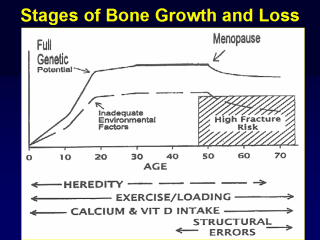| front |1 |2 |3 |4 |5 |6 |7 |8 |9 |10 |11 |12 |13 |14 |15 |16 |17 |18 |19 |20 |21 |22 |23 |24 |25 |26 |27 |review |
 Heaney RP, et al. 2000. Osteo Int. |
This slide shows the stages of bone
growth and loss in human lifetime. Early in life bones grow in size and strength because
more bone tissue is laid down than is removed. By about age 20, we reach what is called our ‘peak bone density’ and our bones are probably the strongest they will ever be. After age 20, we maintain our bone density for a while, and then bone removal starts to overtake replacement and both men and women will lose bone. Women, however, will have an additional rapid period of loss around the menopause due to the sharp decline in ovarian production of estrogen, a hormone which we know has a protective effect on bone. Low bone mass results either from failure to achieve peak bone mass during the first 30 years of life, or from rapid, or accelerated bone loss later in life. Once you reach what is called ‘your fracture threshold’ (loss of ~50%of bone mass), you are at risk of higher rate of Fx. Following attainment of PBM, a gradual loss of bone occurs with ageing. Before the menopause, the amount lost is very small but it then increases to approximately 1-2% per annum over the next 5-10 years. These respective changes in bone mass with the menopause have resulted in enormous interest over the last two decades as to the effectiveness of calcium supplementation in reducing perimenopausal bone loss. |